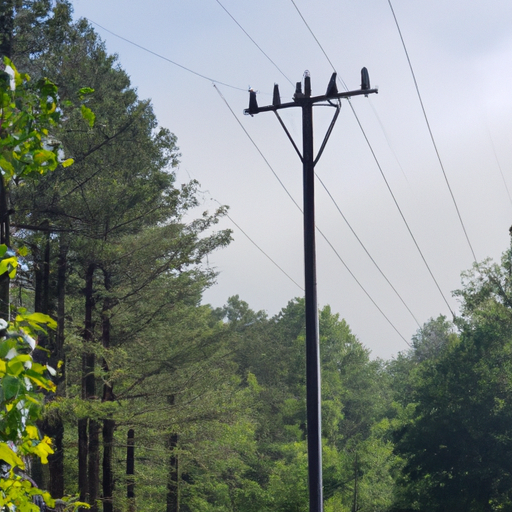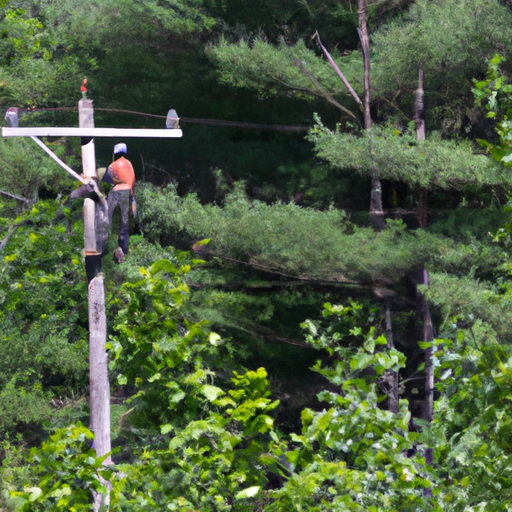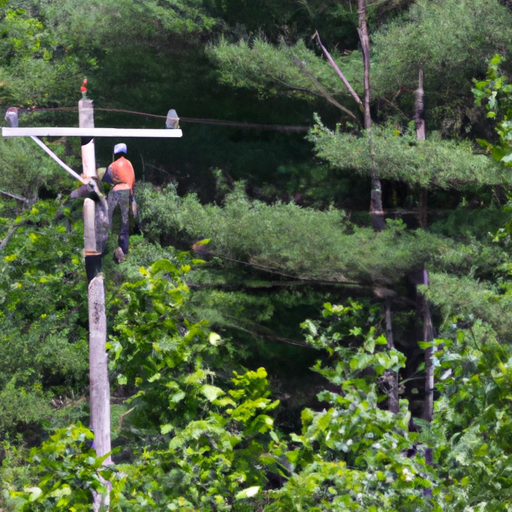In this article, you will learn about the distinction between power linemen and tree trimmers. Both professions involve working on electrical systems and maintaining their functionality. However, there are some key differences in their responsibilities and skillsets that set them apart. Let’s delve into those differences and gain a better understanding of each role.
Power linemen are responsible for the installation, repair, and maintenance of electrical power systems. They work on overhead power lines and ensure that the flow of electricity remains uninterrupted. Power linemen often work at great heights and must possess specialized knowledge of electrical systems and safety protocols. On the other hand, tree trimmers focus on pruning and removing trees that pose a risk to power lines. Their goal is to maintain a safe distance between tree branches and electrical wires. Tree trimmers require expertise in both tree care and understanding electrical hazards.
Understanding the Distinction: Power Linemen vs. Tree Trimmers
When it comes to our everyday lives, there are industries and professionals that are often overlooked but play a crucial role in keeping our environment safe and functional. Power linemen and tree trimmers are two such groups of individuals who work diligently to ensure the reliability and safety of our electrical infrastructure and the proper maintenance of our trees. While they both address different aspects of maintenance and safety, it is important to understand the distinction between these two professions. In this article, we will delve into the roles and responsibilities, required skills and expertise, as well as the training, certification, and safety measures associated with power linemen and tree trimmers.
Roles and Responsibilities of Power Linemen
Power linemen play an essential role in maintaining and repairing power lines, ensuring that electricity is safely transmitted to our homes, businesses, and public spaces. They are responsible for installing and replacing power line equipment, such as transformers, insulators, and switches. Furthermore, power linemen are the first responders during power outages and emergencies, promptly identifying and resolving issues that may compromise the electrical supply.
Training and Certification for Power Linemen
To become a power lineman, specific training and certification are required to ensure competence and safety. While educational requirements vary, most power linemen undergo apprenticeship programs that provide both theoretical knowledge and practical experience under the guidance of experienced professionals. These programs typically last around four years, during which apprentices learn about electrical systems, equipment, safety protocols, and emergency response procedures. Upon completion, power linemen must pass examinations and obtain licenses, demonstrating their proficiency in the field.

Safety Measures for Power Linemen
Working with electricity inherently poses risks, which is why power linemen must adhere to strict safety measures. Personal Protective Equipment (PPE) is an essential component of their work attire, including insulated gloves, safety glasses, and protective clothing. Working at heights is a common occurrence for power linemen, so they must utilize fall protection equipment, such as harnesses and safety lanyards. Additionally, following electrical safety precautions and emergency response procedures ensures the well-being of not only the power linemen themselves but also the general public.
Tools and Equipment Used by Power Linemen
Power linemen rely on a wide range of tools and equipment to perform their duties efficiently and safely. Lineman’s tools, such as pliers, wrenches, and cable cutters, are instrumental in the installation and repair of power line equipment. Bucket trucks, equipped with a hydraulic lift mechanism and a platform, allow power linemen to work at elevated heights while maintaining stability and safety. Insulation and testing equipment, such as voltage detectors and infrared cameras, facilitate the diagnosis and resolution of electrical issues. Pole climbing gear, including climbers, belts, and hooks, enable power linemen to ascend and descend power poles securely.
Roles and Responsibilities of Tree Trimmers
While power linemen focus on maintaining electrical infrastructure, tree trimmers play a crucial role in the proper care and maintenance of trees. Tree trimmers are responsible for trimming and pruning trees to ensure their health, shape, and structural integrity. They also remove trees and branches that present hazards, as well as address the aesthetic concerns of tree maintenance.

Types of Tree Trimming
Tree trimming encompasses various techniques to meet specific objectives. Crown thinning involves selectively removing branches within the canopy to improve ventilation and reduce wind resistance. Crown raising focuses on raising the lower branches to provide clearance for pedestrians, vehicles, or buildings. Crown reduction aims to reduce the overall size of the tree while maintaining its shape and integrity. Hazard trimming, as the name suggests, involves removing branches or trees that pose a risk to surrounding structures or electrical lines.
Safety Measures for Tree Trimmers
Similar to power linemen, tree trimmers must prioritize safety while working at heights and handling sharp tools. Utilizing appropriate PPE, including helmets, safety glasses, and chainsaw-resistant chaps, protects them from potential injuries. Tree trimmers must also be well-versed in safe climbing techniques and understand how to properly secure themselves to the tree. Additionally, proper training and knowledge of specific pruning techniques minimize the risk of damaging the tree or surrounding structures.
Tools and Equipment Used by Tree Trimmers
Tree trimmers rely on various tools and equipment to effectively carry out their responsibilities. Chainsaws are one of the key tools used for cutting and trimming branches. Pruning shears, pole pruners, and hedge trimmers allow for precision cutting and shaping. Climbing gear, such as climbing ropes, harnesses, and climbing spikes, enables tree trimmers to ascend and maneuver in the tree canopy safely. Bucket trucks are often utilized for tree trimming at higher elevations, providing stability and access to difficult-to-reach areas.
Nature of Work: Power Linemen vs. Tree Trimmers
The nature of work for power linemen and tree trimmers differs significantly. Power linemen deal primarily with electrical infrastructure and ensuring the safe transmission of electricity for communities. Their work involves installing and repairing equipment, responding to emergencies, and actively maintaining power lines. On the other hand, tree trimmers focus on tree health and aesthetics, performing pruning, trimming, and removing trees and branches as necessary. Their work contributes to the overall landscape maintenance and the prevention of potential hazards caused by overgrown or diseased trees.
Work Environment: Power Linemen vs. Tree Trimmers
Power linemen often work outdoors in varying weather conditions, ranging from scorching heat to extreme cold. They may have to work during storms and other emergencies, putting themselves at risk for the sake of restoring power. Tree trimmers also work outdoors, encountering diverse environments such as parks, residential areas, and commercial properties. Their work often involves climbing trees and using specialized tools to reach and prune branches at different heights.
Required Skills and Expertise: Power Linemen vs. Tree Trimmers
Power linemen need to have a strong understanding of electrical systems, equipment, and safety protocols. They must possess technical skills to troubleshoot, repair, and install power line equipment. Additionally, physical fitness is crucial, as the job requires climbing poles and traversing various terrains. Tree trimmers, on the other hand, need to have a deep knowledge of tree species, growth patterns, and pruning techniques. They should be skilled in safely operating chainsaws and other cutting equipment.
Training and Certification: Power Linemen vs. Tree Trimmers
To become a power lineman, educational requirements vary, but apprenticeship programs are typically required. These programs encompass on-the-job training and classroom instruction, equipping individuals with the necessary skills and knowledge. Upon completion, power linemen must pass examinations and obtain licenses to work professionally. Tree trimmers also undergo intensive training programs that teach them pruning techniques, safe climbing methods, and the use of specialized tools. While certification is not always mandatory, obtaining certification through organizations such as the International Society of Arboriculture (ISA) can enhance job prospects and demonstrate competency in the field.
Job Outlook and Demand: Power Linemen vs. Tree Trimmers
Both professions exhibit a consistent demand due to the ongoing need for reliable electricity and well-maintained trees. Power linemen face a steady job outlook as the population grows, requiring an expanding electrical infrastructure. Additionally, retirement and turnover within the field create opportunities for new linemen. Tree trimmers also enjoy a stable job outlook, particularly in urban areas where tree care and maintenance are essential for preserving the beauty and safety of the environment.
Conclusion
Understanding the distinction between power linemen and tree trimmers highlights the crucial roles they play in society. Both professions require specialized skills, expertise, and adherence to safety measures. While power linemen ensure the reliable transmission of electricity and promptly respond to emergencies, tree trimmers focus on the maintenance of tree health and the prevention of hazards caused by unkempt trees. By recognizing and appreciating the skills and efforts of these professionals, we can ensure the proper maintenance and safety of our electrical infrastructure and our natural environment.




